- Introduction
- What Is a Network Analyzer?
- Network Analyzers vs. Spectrum Analyzers
- What Do You Use a Network Analyzer For?
- Types of Network Analyzers
- Scalar Network Analyzer
- Vector Network Analyzer
- Large Signal Network Analyzer
- What Aspects To Look For in a Network Analyzer
- Frequency Range
- Dynamic Range
- Measurement Speed
- Trace Noise
- Number of Test Ports
- Size
- Input Power
- Buy a Network Analyzer Trusted by 70% of Engineers Worldwide
- Closing Thoughts From Keysight
- Whenever You’re Ready, Here Are 4 Ways We Can Help You
As an engineer, you understand that a network analyzer is a valuable tool. It is essential for testing, characterizing, and troubleshooting the network parameters of an electrical network. This process is critical for monitoring how a network or device functions in a radiofrequency (RF) circuit.
There are many different types and models of network analyzers on the market, so choosing the right one for your needs can be challenging. This guide aims to make that choice easier by giving you all the information necessary to make the best purchase.
What questions will we answer, and what information will we consider?
- What is a network analyzer?
- What do you use a network analyzer for?
- Types of network analyzers and their functions
- What aspects to look for in a network analyzer
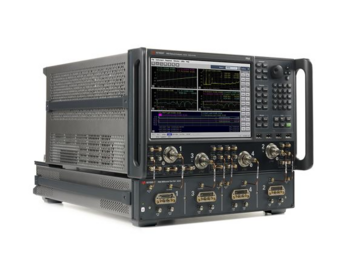
What Is a Network Analyzer?
A network analyzer characterizes network parameters of electronic devices. The most common is a vector analyzer, which measures the amplitude and phase response of a device under test (DUT). The results are generally displayed as a graph, making it easy to visualize the device's behavior under specific conditions.
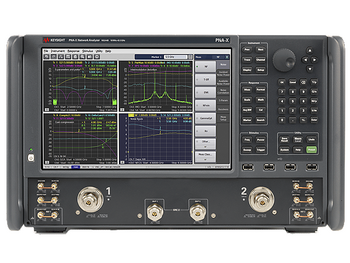
The graph represents the device's amplitude (vertical axis) and phase (horizontal axis) response to an RF signal applied to the DUT. You can adjust the conditions to study the device's response under different conditions, such as frequency, power, and time.
Network Analyzers vs. Spectrum Analyzers
Understanding the difference between a network analyzer and a spectrum analyzer is vital because they are often confused. While both can measure the response of a device to a high frequency signal, they differ in a few ways.
Network analyzers measure the electrical characteristics of a network. They characterize the impedance of a circuit and measure the circuit's response to an applied signal. The signal may be sinusoidal or modulated, such as a pulse or square wave.
Spectrum analyzers measure the amplitude and frequency of a signal. They identify spectral components in a signal and investigate the behavior of an oscillator. An oscillator is an electronic circuit that produces continuous waveforms without an external input signal.
Each analyzer has unique capabilities making them suitable for different applications. Using both gives you a complete picture of the device under test.
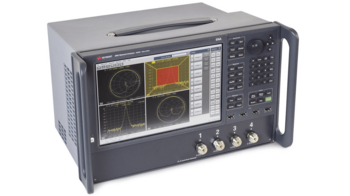
What Do You Use a Network Analyzer For?
A network analyzer has many applications. Some of these include
- Sound and vibration measurements. Network analyzers measure the sound pressure level in an acoustic environment or the acceleration of an object in response to a vibration input. The wide range of possible applications for network analyzers makes them an essential tool for engineers and physicists who work with sound and vibration. These are low frequency measurements.
- High-frequency measurements. Network analyzers provide voltage and current waveforms to analyze the behavior of a circuit or component. By measuring the impedance, phase, and magnitude of the waveforms, you can determine the characteristics of the circuit or component under test. Additionally, network analyzers measure the frequency response of a system, identify resonances, and optimize the performance of a circuit.
- Filter performance evaluation. Network analyzers determine a filter's frequency response, as well as its impedance and phase shift. By evaluating these parameters, a network analyzer can troubleshoot problems and help optimize the filter's performance.
- Circuit noise performance measurements. Network analyzers measure the noise power of circuits at different frequencies, identifying the sources of noise and tracking their evolution over time. This information is essential for optimizing circuit components' design and troubleshooting problems in existing circuits. By measuring the noise immunity of circuits, a network analyzer provides valuable information for protecting sensitive electronic equipment from interference.
- Various RF-based measurements. Network analyzers measure the reflection coefficient of an impedance mismatch. This information can determine the location and cause of the mismatch and correct it. Network analyzers also measure the insertion loss of a device, such as an amplifier or filter. This measurement is helpful for troubleshooting issues and ensuring the device performs as expected.
Types of Network Analyzers
There is a wide range of options on the market for network analysis. Depending on the desired application, each network analyzer has unique features and pros and cons.
Now that we have covered the fundamentals of network analyzers let's look at three stand-out choices:
- Scalar network analyzers
- Vector network analyzers
- Large signal network analyzers
Scalar Network Analyzer
Scalar Network Analyzers (SNAs) measure the performance of scalar networks. A scalar network can be characterized entirely by a single amplitude-related quantity, such as impedance.
SNAs typically measure the impedance of passive networks, such as resistors, inductors, and capacitors. They do this by injecting test signals into the network and measuring the response. SNAs measure various amplitude-derived parameters, including attenuation, phase shift, and distortion. The results of these measurements assess the network's overall performance and identify any areas of improvement.
SNAs frequently work with other testing tools, like vector network analyzers. Together, these analyzers can provide a comprehensive picture of network performance.
| Scalar Network Analyzer Pros | Scalar Network Analyzer Cons |
|---|---|
| A high degree of accuracy. Such accuracy is essential for applications requiring precise measurements, especially when operating at high speeds. | Only measure the magnitude of a signal and not the phase. As a result, SNAs cannot measure certain signal distortions that could indicate a problem. |
| Measure a wider range of frequencies. This ability makes SNAs ideal for use in high-frequency applications. | Only measure one network parameter at a time. If you want to measure multiple parameters, you have to take multiple measurements, which can be time-consuming. |
| Superior scalability. To support new measurements or applications, SNAs are easily upgradeable. | Produce large amounts of data that can be difficult to interpret. This data can also be challenging to store and share. |
| Fast sample rates. This high speed allows for quick and accurate measurements of electronic devices. | Generally more expensive than other network analyzers. |
Vector Network Analyzer
Vector Network Analyzers (VNAs) measure the characteristics of a signal. They work by sending a test signal into a device under test (DUT) and then measure the response. The most common features measured are frequency, amplitude, and phase.
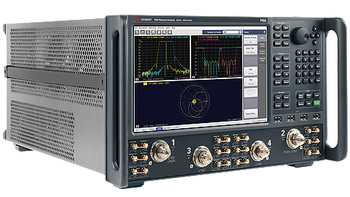
Vector network analysis can also measure the distortion of a signal and the noise floor. This makes VNAs helpful in developing and testing electronic devices like radios and cell phones.
VNAs are essential for radio frequency (RF) and microwave component analysis of various passive and active devices, including filters, antennas, and power amplifiers. They are a go-to instrument for impedance measurements, transmission coefficient, insertion loss/gain, reflection, and s-parameter measurements during design and production processes.
| Vector Network Analyzer Pros | Vector Network Analyzer Cons |
|---|---|
| Capture and display the magnitude and phase of a signal. VNAs allow for a more comprehensive analysis. | Potentially expensive. VNAs could be a prohibitive option if you are just starting out as an engineer. |
| Wide dynamic range. VNAs measure signals with an extensive range of amplitudes. | Limited frequency range for measuring signals. This can be problematic for some applications. |
| A high degree of measurement accuracy and precision. VNAs are essential pieces of test equipment for high-frequency applications. | Limited dynamic range. Trying to measure minimal signals in the presence of substantial signals can be difficult because of the limited range. |
| Take measurements at specific points in time. You can trigger a VNA to accomplish this. This feature is useful for capturing intermittent or transient signals. | Specialized software and hardware are required as VNAs use digital modulation techniques. The need for these can be difficult to manage if you are an engineer on a budget. |
Large Signal Network Analyzer
Large Signal Network Analyzers (LSNAs) characterize the frequency response of electronic devices and circuits. They work by injecting a known signal into the device under test and then measuring the output signal.
LSNAs then use this information to graph the device's frequency response. This type of analysis is significant for RF devices which often have a non-linear frequency response, such as amplifiers and filters.
These analyzers are also helpful in characterizing power supplies, as they can help identify any ripple or distortion in the output voltage.
| Large Signal Network Analyzer Pros | Large Signal Network Analyzer Cons |
|---|---|
| Extremely accurate. LSNAs take into account the non-linear effects that occur in real-world circuits. | Produce lots of heat. This proves problematic in lab environments. |
| Measure a wide range of frequencies. They use a technique called frequency-domain analysis, allowing them to identify the frequency components of a signal. | Measurements are adversely affected by reflections or other impedance mismatches in the device under test. It is difficult to get accurate results in situations where there are multiple reflection points. |
| Less susceptible to noise. LSNAs use a higher input power, which helps to reduce the noise floor. As a result, they are an excellent choice for applications that need high accuracy or a wide frequency range. | Complex to operate and often require specialized training to get the best out of them. |
| Less likely to damage sensitive components. The large signal excitations used in these tests do not have the high-frequency content that can cause damage to delicate circuits. | Less portable than other signal network analyzers. LNSAs can be less convenient for fieldwork. |
What Aspects To Look For in a Network Analyzer
When purchasing a network analyzer, you will need to consider the different aspects they offer. Once you understand the combination of specs and functions that you need, you can start evaluating different models to see which one is the best fit.
Let's take a look at the seven main network analyzer aspects.
- Frequency Range
- Dynamic Range
- Measurement Speed
- Trace Noise
- Number of Test Ports
- Size
- Input Power
Frequency Range
It is crucial to select a network analyzer that can support the frequencies you need. The larger the frequency range, the more flexibility the analyzer offers.
There are three main types of frequency ranges: low frequency, high frequency, and ultra-high frequency.
- A low-frequency network supports frequencies up to 1GHz. Low-frequency networks typically include technologies such as Ethernet, Token Ring, and ARCNET.
- A high-frequency network supports frequencies between 1GHz and 10GHz. Fiber optic and wireless network applications typically use high-frequency networks.
- An ultra-high frequency network supports frequencies above 10GHz. Satellite and military applications typically use ultra-high frequency networks.
Regardless of the frequency, network analyzers help optimize a network's performance by testing its frequency range and identifying areas where it is not performing optimally.
Dynamic Range
The dynamic range of a network analyzer is the range of signal levels over which it can provide accurate measurements. Dynamic range is also known as measurement range and is typically measured in decibels (dB).
A network analyzer with a high dynamic range can accurately measure both small and large signal levels. In contrast, a network analyzer with a low dynamic range may only be able to measure small signal levels accurately.
An excellent example of this is when measuring the noise level of a network. A network analyzer with a high dynamic range will be able to measure both the small and the large signal level of the desired signal. In contrast, a network analyzer with a low dynamic range will only be able to measure the small signal level of the noise.
Some network analyzers have an adjustable dynamic range. The adjustability allows you to select the range of signal levels over which the analyzer will provide accurate measurements. This is useful for applications where the signal to be measured is unknown in advance or where the signal level varies over time.
Measurement Speed
Measurement speed is a critical performance metric for network analyzers. It refers to the time it takes for the unit to perform a measurement cycle. A cycle includes
- Calibrating the instrument
- Setting up the test
- Taking the measurement
- Displaying the results
The faster the measurement speed, the more efficient the analyzer will be in terms of time and resources.
A unit with a high measurement speed may be overkill for a simple application, while a slower unit may be unable to keep up with complex measurements. For data rate testing and troubleshooting live networks, measurement speed is critical in determining whether a particular analyzer is suitable for the task.
It is important to consider not only the raw measurement speed but also the scalability of a network analyzer in terms of both performance and price. Scalability is the ability to upgrade a network analyzer to meet your changing user needs.
For example, a network analyzer with a fast measurement speed may perform basic tests quickly, but it may not be able to scale up to meet the needs of more complex testing, and vice versa.
Ultimately, the right choice for you depends on finding an analyzer that perfectly balances relevant speed and cost-effectiveness.
Trace Noise
Noise is any unwanted signal that interferes with the proper functioning of a system. Trace noise, specifically, is a type of noise that affects the accuracy of measurements made by a network analyzer.
Trace noise levels are instrumental in determining the accuracy of a network analyzer because they can introduce errors in the measurements. The higher the trace noise level, the greater the potential for error. It is vital to ensure that trace noise levels are as low as possible to maintain the accuracy of measurements.
There are various ways to reduce trace noise levels, such as using shielded cables and avoiding sources of electromagnetic interference. Undertaking these measures makes it possible to reduce the error introduced by trace noise and maintain accurate measurements.
The type of analyzer you use will also affect trace noise levels. For example, a vector network analyzer has lower trace noise levels than a scalar network analyzer.
Number of Test Ports
Network analyzers can have varying numbers of test ports. More test ports mean the device can simultaneously support more measurements, which is ideal for troubleshooting complex network issues.
Having more test ports allows you to create a custom network analyzer configuration that helps improve your measurements' accuracy by providing additional reference points. The ability to do this is crucial when measuring devices with multiple ports, such as switches and routers.
An analyzer with multiple test ports can save time and money because it allows you to make all the necessary measurements in one go.
When choosing a network analyzer, consider how many test ports each device offers and how many you need. Remember that the more ports there are, the more expensive the analyzer will be.
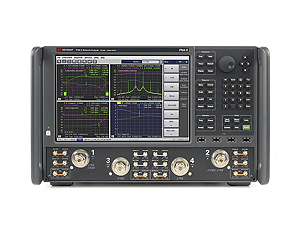
Size
The size, form, and portability of a network analyzer can impact both the efficiency of deployment and data safety.
There are several advantages to selecting a smaller network analyzer.
- They are easier to transport and set up, saving valuable time when deployed in the field.
- They are not easily damaged in transit, making them less likely to lose critical data.
- They require less power to operate, which can be invaluable in remote locations with no reliable power sources.
Network analyzers come in various forms. Some are rack-mounted, while others are portable handheld devices. Do you need an analyzer that can be easily transported and set up in the field? Or do you need one that can easily integrate into your existing network infrastructure?
Input Power
Input power is the maximum power that can be safely supplied to the device under test without damaging the equipment. Input power is not the same as the power requirements of the network analyzer, which is the power required to operate the device.
Input power directly impacts the types of devices tested. If you need to test a device with high power consumption, you will need a network analyzer with high input power.
Typically, watts (W) or milliwatts (mW) express a network analyzer's input power. The most common input power levels are 1 W, 2.5 W, and 5 W.
Network analyzers require a certain amount of input power to make accurate measurements. The amount of input power required depends on the impedance of the device under test and the amount of power needed to run the test.
In general, higher-impedance devices require more input power. For example, a 50-ohm device would require less input power than a 1000-ohm device. Choosing a network analyzer with the correct input power is essential to ensure that your equipment does not damage during testing and gives you accurate results.
Input power is most important for USB-powered devices as not all have equal current capabilities. For instance, if you have a device that requires more than 500mA, you need to check that the analyzer can provide this.
Some USB 3.0 ports can provide up to 900mA, but many only provide 500mA. If in doubt, always check with the device manufacturer you are testing to determine the maximum input power required.
Make sure you to not overlook the effects of cable losses when choosing a network analyzer. Cable losses can reduce the amount of power delivered to the device under test, so you want to select an analyzer with enough input power to offset these losses.
Buy a Network Analyzer Trusted by 70% of Engineers Worldwide
Purchasing a network analyzer is an investment. Like any investment, you want to ensure you are getting your money's worth and a product that fits the task. With so many different analyzers on the market, making that decision can be difficult.
At Keysight, we want to make that decision easier for you by providing the best network analyzers on the market. Why should you buy from us? The answer is simple! When you purchase a Keysight Premium Refurbished instrument, you buy like-new quality while saving up to 70%.
Keysight Premium Used equipment comes from the same factory that manufactures and tests new products. So it must pass the same comprehensive tests and calibration as a new product to meet Keysight's quality standards.

We offer a fast two-week delivery time*, which is 6-19 weeks faster than other resellers. We also provide an upgradable warranty, giving you peace of mind knowing you are getting a quality product backed by a trusted manufacturer.
(* Two weeks shipping time offer available for US customers only. Dependent on item availability and location.)
Closing Thoughts From Keysight
In this buying guide, we have covered the key features and uses of network analyzers. A better understanding of this information is the key to purchasing an excellent network analyzer.
Ask yourself, what are the tasks I need this analyzer to perform? What analyzer functions will most effectively and efficiently help me achieve these? The answers to these questions will help you find the perfect network analyzer.
Keysight is a leading manufacturer of the best quality network analyzers, offering a wide range of models to meet your specific needs.
See Keysights Used Equipment for the widest selection of discounted, high-quality, and premium refurbished network analyzers.
Request a quote for any of our equipment to talk to a sales agent today!
Whenever You’re Ready, Here Are 4 Ways We Can Help You
- Browse our premium used network analyzer offers
- Call tech support US: 1 800 829-4444
Press #, then 2. Hours: 7am – 5pm MT, Mon– Fri - Talk to our sales support team by clicking the icon (bottom right corner) on every offer page
- Talk to your account manager for custom deals